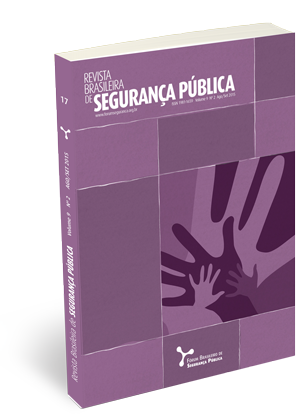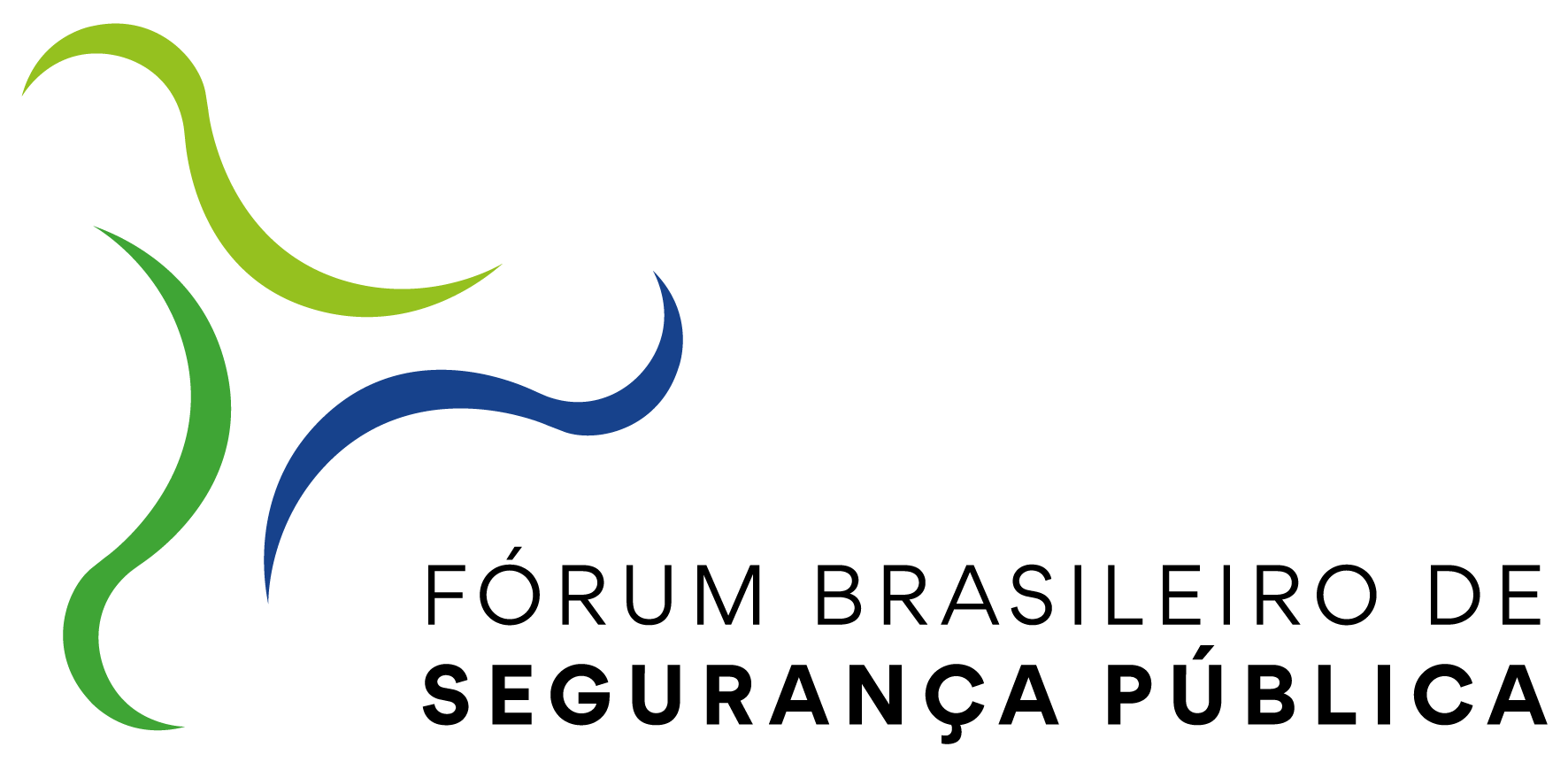A prevenção de homicídios de crianças na América Latina: um imperativo de direitos humanos
DOI:
https://doi.org/10.31060/rbsp.2015.v9.n2.498Palavras-chave:
Direitos das crianças, Homicídio, Prevenção da violênciaResumo
Este artigo foi elaborado para a ocasião do Workshop sobre redução de homicídios e violência contra crianças, que ocorreu no 9º Encontro Anual do Fórum Brasileiro de Segurança Pública. O artigo procura explorar estratégias, levadas a cabo pelo governo e sociedade civil, para a prevenção da violência contra as crianças na comunidade, especialmente com relação à prevenção de homicídios. Considera que o respeito aos direitos das crianças deva ser parte das leis e políticas públicas, estabelecendo proteção adicional a essa parcela da população nas suas relações com o Estado, a sociedade, os adultos e a família. O artigo conclui que a prevenção à violência contra as crianças deve ser um assunto de todos. Dessa forma, todos compartilham as mesmas responsabilidades quando se trata dos direitos das crianças. É preciso proporcionar segurança a elas e protegê-las contra a violência e o abuso, como uma questão de direito.Downloads
Referências
APPIOLAZA, M.; QUIRÓS ESPINOZA, A. Y. Investigación y sistematización de prácticas efectivas para la prevención y reducción de la violencia armada que afecta a niños, niñas y adolescentes. UNICEF/LACRO, set. 2014, 188 p.
BRINKS, Daniel M. Informal Institutions and the Rule of Law: The Judicial Response to State Killings in Buenos Aires and São Paulo in the 1990s. Comparative Politics, v. 36, n. 1, out. 2003.
BUMPUS, J. et al. Best Practices in Reducing Violent Homicides Rates: Honduras, El Salvador, Mexico. Princeton: Woodrow Wilson School of Public & International Affairs, Princeton University, 2013, 45p.
COMISSÃO INTERAMERICANA DE DIREITOS HUMANOS. Relatoria sobre os Direitos da Criança. Report on Corporal Punishment and Human Rights of Children and Adolescents, Washington, OEA/Ser.L/V/II.135, Doc. 14, 5 ago. 2009.
CRIN. CRINMAIL 1436. London: CRIN, jul. 2015.
FRATE, ANNA A. D.; MARTINO, LUIGI D. Every Body Counts: Measuring Violent Deaths. Research Note N. 49, Armed Violence, 2015.
GENEVA DECLARATION ON ARMED VIOLENCE AND DEVELOPMENT. Global Burden of Armed Violence 2015: Every Body Counts. Geneva: Geneva Declaration, 2015.
GRADUATE INSTITUTE OF INTERNATIONAL AND DEVELOPMENT STUDIES. Small Arms Survey 2012, Moving Targets. Geneva: Cambridge University Press, 2012. 355 p.
HUMAN RIGHTS WATCH. World Report 2014 Events of 2013. New York: HRW, 2014. 682 p.
IACHR; OAS. Report on Citizen Security and Human Rights. OEA/Ser.L/V/II. Doc. 57.31 dez. 2009.
IMBUSH, P.; MISSE, M.; CARRIÓN, f. Violence Research in Latin America and the Caribbean. International Journal of Conflict and Violence [Violence Research in Latin America and the Caribbean: a Literature Review], v.5, n. 1, p. 88-153, 2011.
INTER AMERICAN COMMISSION ON HUMAN RIGHTS. Informe sobre seguridad ciudadana y derechos humanos. Report on citizen security and human rights. Washington: OEA, 2009. OEA/Ser.L/V/II. Doc. 57
KORTHUIS, A. The Central America Regional Security Initiative in Honduras.Working paper.Washington: Woodrow Wilson Center/Wilson Center Latin America Program, sept. 2014, 61 p.
MARTINO, L.; ATWOOD, D. Reducing Illicit Arms Flows and the New Development Agenda. Research Note N. 50, Armed Violence, 2015.
MOESTUE, H.; MOESTUE, L.; MUGGAH, R. Youth violence prevention in Latin America and the Caribbean: a scoping review of the evidence. Norwegian Peace Building Resource Centre (NOREF), ago. 2013, 15 p.
MOESTUE, H.; MUGGAH, R. Digitally Enhanced Child Protection: how new technology can prevent violence against children in the Global South. Strategic Paper 10. Rio de Janeiro: Igarapé Institute, , nov. 2014.
MOVIMENTO MUNDIAL POR LA INFANCIA; SRSGVAC. Mapeo Región América del Sur: Implementación de las Recomendaciones del Estudio Mundial sobre la Violencia contra los Niños y Niñas. Montevideo: 2011. 244 p.
MUGGAH, R. Researching the urban Dilema: Urbanization, Poverty and Violence. International Development Research Centre, mai. 2012, 118 p.
MUGGAH, R.; DOE, S. Es hora de hacer frente al problema de la violencia en America Latina y el Caribe. Huffington Post Blog, 4 fev. 2013.
OEA. Alertamérica, Observatorio Hemisférico de Seguridad. Informe sobre Seguridad Ciudadana en las Américas: Estadísticas Oficiales de Seguridad Ciudadana Producidas por los Estados Miembros de la OEA. Washington, DC: OEA, 2012.
ONU; PINHEIRO, Paulo Sérgio. World report on violence against children. Geneva: United Nations Publishing Services, Services Concept, ATAR Roto Presse, 2006.
OSRSG. Office of the Special Representative of the Secretary General on Violence against Children. Why Children’s Protection from Violence should be at the Heart of the Post 2015 Development Agenda: A Review of Consultations with Children on the Post 2015 Development Agenda. New York: OSRSG-VAC, Oct. 2014, 89 p.
PINHEIRO, P. S. Democratic Governance, Violence, and the (un)Rule of Law. [Brazil: The Burden of the past; The Promise of the future Daedalus]. Daedalus, v. 129, n. 2, 2000, p.119-141.
PINHEIRO, P. S. World Report on Violence against children (uNVAC).Geneva: UN, 2006. 363 p.
PINHEIRO, P. S. Seguimiento de las Recomendaciones del Estudio Mundial sobre la Violencia contra los Niños. Comisión Permanente Iniciativa Niñ@Sur para la Promoción y Protección de los Derechos de la Infancia y Adolescencia, Brasília, 7 maio 2015. Discurso de abertura.
PINHEIRO, P. S.; UNITED NATIONS. Report of the Independent Expert for the Study of Violence against Children. General Assembly, 61st Period of Sessions, A/61/299. Promotion and Protection of the Rights of Children. 29 aug. 2006, 34 p.
RATTON, J. L. et al. O pacto pela vida e a redução da homicídios em Pernambuco. Artigo estratégico. Rio de Janeiro: Instituto Igarapé, ago. 2014a. 22 p.
RATTON, J. L. et al. Pact for Life and the Reduction of Homicides in the State of Pernambuco. International Journal of Security & Development, v. 3, n. 1, p. 1-15, 2014b. DOI: http://dx.doi.org/10.5334/sta.dq.
REDLAMYC. Estudio de balance regional sobre la implementación de la Convención sobre los Derechos del Niño en América Latina y el Caribe. Mexico, DF: REDLAMYC, 2009. 166 p.
SAVE THE CHILDREN. Evaluación Final Externa:Proyecto “fomentando una Cultura de Paz en cuatro colonias del área periurbana de Comayagüela en el Municipio del Distrito Central, Departamento de francisco Morazán, Honduras”. Jul. 2013.
SOLÓRZANO, I. et al. Catalyzing individual and social change around gender, sexuality, and HIV: Impact evaluation of Puntos de Encuentro’s communication strategy in Nicaragua.Horizons Final Report. Washington, DC: Population Council,2008.
TAMAYO, O. M. Programa Participación Ciudadana para la Paz-PACIPAz: Manual de Práctica El Golombiao, Programa Presidencial Colombia Joven. Bogotá: 2006.
UN. Special Representative of the Secretary General on Violence against Children. UN Study on Violence against Children: Why the UN study? [200-?]
UN. Resolution adopted by the General Assembly: Rights of the child, Document A/RES/57/190, 19 feb. 2003.
UN. Human Rights Council. Annual Report of the Special Representative of the Secretary General on Violence against Children, Document A/HRC/22/55, 4 jan. 2013.
UNDP. Regional Human Development Report 2013-2014, Citizen Security with a Human face: Evidence and Proposals for Latin America. New York: UNDP, 2013. 36p.
UNICEF. Eliminating Violence Against Children:Handbook for Parliamentarians, Inter Parliamentary Union, New York, Unicef, n. 13, 2007, p. 62. Disponível em: <http://www.unicef.org/publications/in-dex_41040.html>.
UNICEF. Office of the Special Representative of the Secretary General on Violence against Children. Toward a World Free from Violence: global survey on violence against children. New York: OSRSG-VAC, 2013, 160 p.
UNICEF. Ending Violence Against Children: Six Strategies for Action –#ENDviolence. New York: UNICEF, Sep. 2014a. 66 p.
UNICEF. Hidden in plain sight: a statistical analysis of violence against children. New York: UNICEF, 2014b, 202 p.
UNICEF. #ECA25Anos – Estatuto da Criança e do Adolescente: Avanços e desafios para a infância e adolescência no Brasil. Brasília, Df: Unicef Brasil, 2015.
UNICEF COSTA RICA. Ministerio de Justicia y UNICEF presentan iniciativa para prevenir el uso de armas por medio de la música y el arte. San José: UNICEF Costa Rica, 2014.
UNODC. Global Study on Homicide 2011: Trends, Contexts, Data. Vienna: UNODC, 2011. 125 p.
UNODC. Global Study on Homicide 2013: Trends, Contexts, Data. Vienna: UNODC, 2013. 166 p.
WAISELFISZ, J. J. Mapa da violência 2012: a cor dos homicídios no Brasil. Rio de Janeiro: CEBELA, FLACSO; Brasília: SEPPIR/PR, 2012. 40 p.
WATTS, J. Latin America leads world on murder map, but key cities buck deadly trend. The Guardian, 6 maio 2015.
WHO. Violence prevention: the evidence. Geneva: WHO, 2010. 134 p.
WHO. Global Status Report on Violence Prevention 2014. Geneva: WHO, 2014. 292 p.
WOLA. Youth Gangs in Central America: Issues in Human Rights, Effective Policing, and Prevention. Washington: WOLA, nov. 2006, 32 p.
Downloads
Publicado
Como Citar
Edição
Seção
Licença
Copyright (c) 2015 Revista Brasileira de Segurança Pública

Este trabalho está licenciado sob uma licença Creative Commons Attribution 4.0 International License.
Licenciamento
A Revista Brasileira de Segurança Pública usa a Licença Creative Commons como forma de licenciamento para suas obras publicadas. A licença utilizada segue o modelo CC BY 4.0 - Attribution 4.0 International.
Para consultar os dirietos permitidos direcione-se para a licença completa ou para a nossa página de Direitos dos autores e Licenças.



